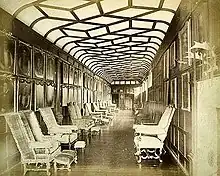Oliver Browne was a London upholsterer and furniture maker in the 17th century who worked for aristocrats and the royal court. His business partners included John Baker, another upholsterer or "upholder", who worked for the royal family.[1] Baker had been "upholster" for the household of Prince Henry.[2] Baker's son, also John Baker, continued the business after the Restoration.[3]
Fashionable commissions

Browne worked for Lionel Cranfield, 1st Earl of Middlesex, who was Keeper of the Wardrobe. A number of Browne's bills for Cranfield's own houses survive at the Kent History and Library Centre, Maidstone. Cranfield's homes included Chelsea House, which he bought in 1619 and improved employing the services of Inigo Jones and Nicholas Stone, and Copthall in Essex. Furnishings were supplied by Oliver Browne and John Baker, and painted and gilded by Thomas Capp. These included a suite of furnishings for Cranfield's second wife Anne Brett's "lying-in" at Chelsea in 1621 with a cradle with a canopy of crimson damask for James Cranfield in 1621. Furniture from Copthall was taken to Knole in 1701.[4]
A bed survinging at Knole (National Trust) is thought to have been one of Cranfield's commissions from Baker and Browne. The silk hangings are decorated with "spangles" or "oes", early modern sequins, and the piece has long been known as the "Spangled Bed".[5] The collection also includes an influential early sofa or couch design, known as the "Knole Settee".[6]
King James became increasingly infirm, but continued to ride and hunt. In December 1624, Oliver Browne provided six portable velvet chairs to use at the hunt, and six special Spanish leather chairs to lift him to and from his bed.[7] Browne and Baker provided textiles for the hearse or catafalque designed by Inigo Jones in Westminster Abbey for the king's funeral.[8]
In 1644, Oliver Browne was upholsterer to the Houses of Parliament. He was still working with John Baker, and they petitioned for payment for the hire of tapestry from Oatlands Palace used to hang rooms near the Parliament Chamber.[9] Browne and Baker were paid £180 for the hire of these four suites of hangings and other services to the "House of Peers" in 1646.[10]
References
- ↑ The Parliamentary Or Constitutional History of England, 6 (London, 1751), p. 210.
- ↑ A Collection of Ordinances and Regulations for the Government of the Royal Household (London, 1790), p. 334
- ↑ Tessa Murdoch, 'Worthy of the monarch: immigrant craftsmen and the production of state beds, 1660–1714', Randolph Vigne & Charles Littleton, From Strangers to Citizens: The Integration of Immigrant Communities in Britain, Ireland, and Colonial America, 1550-1750 (London, 2001), p. 151.
- ↑ Edward Town, 'A Biographical Dictionary of London Painters, 1547–1625', Walpole Society, 76 (London, 2014), p. 51: Edward Town & Olivia Fryman, 'A rich inheritance: Lionel Cranfield's legacy at Knole', National Trust Historic Houses and Collections Annual, Apollo (2016), pp. 35-7.
- ↑ Emma Slocombe, 'Ancient Furnishing: The Display and Alteration of Upholstered Seat Furniture and Textiles Associated With The Brown Gallery, Knole', Furniture History, 50 (2014), pp. 297-325: Annabel Westman, Fringe, Frog & Tassel: The Art of the Trimmings-Maker (London, 2019), p. 24.
- ↑ Christopher Rowell, 'A Set of Early Seventeenth-Century Crimson Velvet Seat Furniture at Knole: New Light on the Knole Sofa', Furniture History, 42 (2006), pp. 27-52.
- ↑ John Philip Hore, The History of Newmarket: And the Annals of the Turf, vol. 1 (London, 1885), pp. 260-1: Mary Elizabeth Arendas, 'The Nature of Applied Textiles on Furniture of the English Renaissance', thesis, University of Cornell (1964).
- ↑ Anthony Harvey & Richard Mortimer, The Funeral Effigies of Westminster Abbey (Boydell, 1994), pp. 69-70.
- ↑ HMC 6th Report (London, 1877), p. 22.
- ↑ Journal of the House of Commons, 1646-1648, vol. 5 (London, 1802).